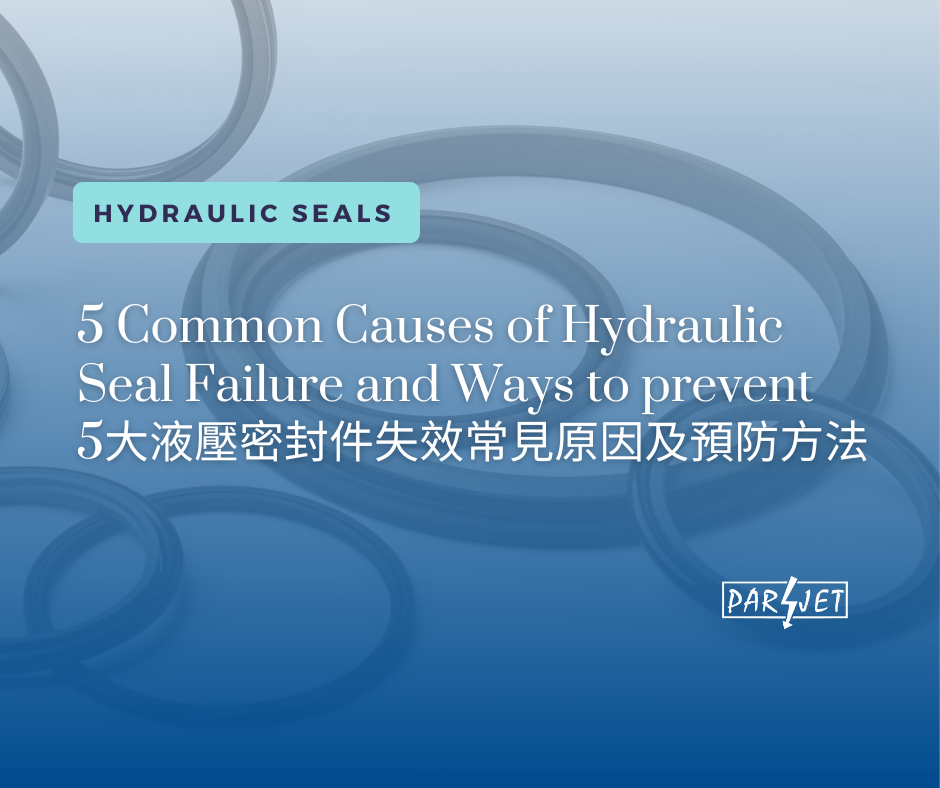5 Common Causes of Hydraulic Seal Failure and Ways to prevent
Hydraulic seals are essential components in hydraulic system, providing a means for fluid power to be converted to linear motion. These hydraulic seals are generally soft, non-metallic rings captured in a groove or fixed in a combination of rings, forming a seal assembly to block or separate fluid in reciprocating motion applications. Made from materials such as polyurethane, rubber, or PTFE, hydraulic seals must withstand specific operating conditions, including fluid type, pressure, chemical compatibility, and temperature.
Hydraulic seals play a vital role in preventing leakages and protecting components like rods in hydraulic pumps and cylinders. However, they often fail, leading to significant issues such as aggravated fluid leakages, systematic contamination, and blowouts. Understanding the common causes of hydraulic seal failure can help in preventing these problems and maintaining the efficiency of hydraulic systems.
Common Causes of Hydraulic Seal Failure:
- Chemical Corrosion (Degradation)
Certain chemicals, including new fluid additives like amine preservatives, can damage the backbone of the rubber polymer in seals, making them brittle and prone to premature failure. Seals are also susceptible to breakdown if exposed to acids or other corrosive materials.
- Contamination (Pollution, Dirt Ingress)
External contaminants such as dust, mud, and weld splatter can infiltrate hydraulic cylinders and attach to the rods, leading to dirty and less reliable seals. This contamination can result in seal failure and compromise the entire cylinder's functionality.
- Hardening (Stiffening, Brittleness)
Hydraulic cylinders typically operate effectively with hydraulic fluids at temperatures not exceeding 180°F. Exposure to higher temperatures can cause seals to harden, losing their elasticity and leading to cracks and failure.
- Swelling (Expansion, Softening)
Hydraulic seals are designed to be compatible with specific fluids. Using incompatible fluids can cause seals to swell, lose their shape, and become loose over time, resulting in significant issues like leaks.
- Improper Installation (Bad Fitting, Incorrect Mounting)
Improper installation of hydraulic seals can result in immediate failure or reduced lifespan. Without the necessary skills and tools, such as piston seal compressors and adhesives, incorrect installation methods can cut or dent the seal's lip, reducing its efficiency.
Parjet’s Advanced Hydraulic Sealing features:
Parjet offers high-performance sealing solutions specifically designed to address the common causes of hydraulic seal failure. Here are 3 key features of Parjet's hydraulic seals that provide superior reliability and longevity:
Superior Chemical Resistance
Parjet’s hydraulic seals are made from advanced materials with exceptional chemical resistance. This ensures that the seals can withstand exposure to a wide range of hydraulic fluids and chemicals without degrading, maintaining their integrity and performance over time.
Temperature Resilience
The high-performance materials used in Parjet’s seals offer excellent resilience to extreme temperatures. Whether operating in high-heat environments or in frigid conditions, Parjet’s hydraulic seals retain their flexibility and strength, preventing issues related to temperature-induced degradation.
High Durability and Wear Resistance
Parjet’s hydraulic seals are engineered for high durability, with materials that resist mechanical wear and tear. The seals are designed to withstand the constant motion and pressure of hydraulic systems, minimizing abrasion and extrusion. This results in longer-lasting seals that provide reliable performance and reduce the need for frequent replacements.
We offer a wide range of hydraulic seals to meet diverse industry needs. Our hydraulic sealing solutions include:
Piston Seals: Engineered to fit tightly around the piston rod or cylinder bore, piston seals prevent fluid leakage during reciprocating motion, ensuring efficient cylinder performance.
Rod Seals: Designed to seal the reciprocating motion of hydraulic cylinder rods, rod seals prevent leakage of hydraulic fluid and protect the system from contaminants.
Wiper Seals: Also known as scraper seals, wiper seals clean contaminants such as dirt and moisture from hydraulic cylinder rods during retraction, prolonging the lifespan of other seals and components.
Material Variety for Different Applications:
Parjet’s hydraulic rubber seals are made from a variety of materials to suit different application requirements. Some commonly used materials include:
Nitrile (NBR)
Fluorocarbon (FKM/Viton®)
Polyurethane (PU)
PTFE
*Tailor-made compounds are available upon your request*
Custom Hydraulic Sealing Solutions:
We understand that each hydraulic application is unique, with specific requirements and operating conditions.
As a result, our engineering team uses 10+ advanced and world-known CNC precision lathes to design and manufacture hydraulic seals tailored to your application, ensuring optimal performance and sealing efficiency.
With our extensive experience, commitment to quality, and advanced manufacturing capabilities, Parjet is the trusted partner for all your hydraulic sealing solutions.
For more information, please contact us.






